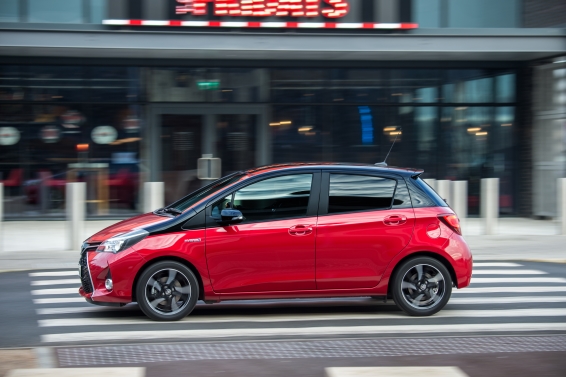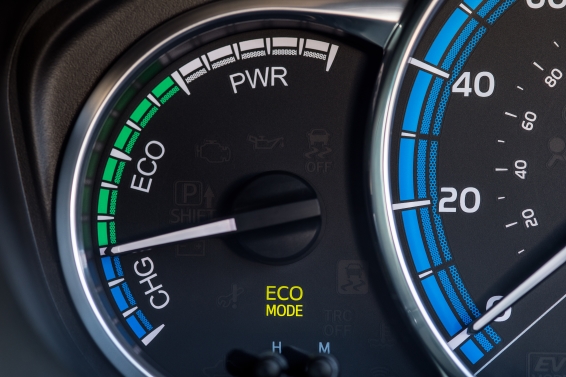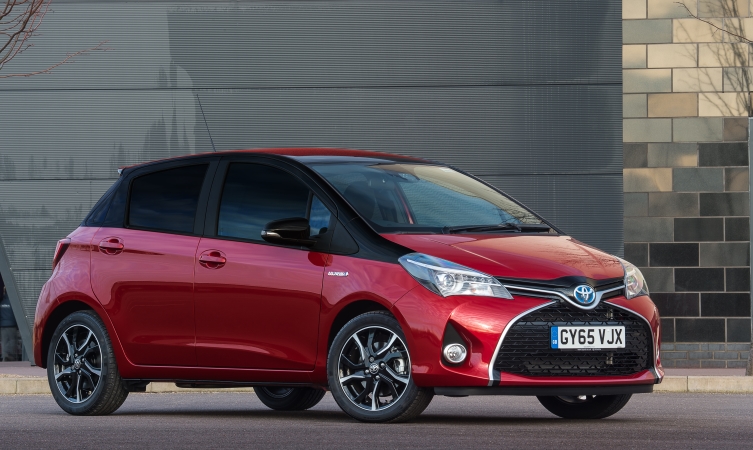The Toyota Yaris Hybrid is the flagship model in the Yaris range, a small hybrid car delivering all the advantages of hybrid motoring without any compromise in practicality. Ideal for urban driving, it is able to complete many journeys on electric power alone.
Key to the Yaris Hybrid’s economy is Toyota’s latest Hybrid Synergy Drive powerplant and e-CVT automatic gearbox. Available in a choice of four trim levels – Active, Icon, Design and Excel – the five-door Yaris Hybrid supplements the petrol and diesel Yaris models and brings hybrid technology to even more drivers.

Driving
The Toyota Yaris Hybrid is the perfect hybrid car for today’s fast-paced urban world, with nippy performance and agile handling. Its 98bhp full hybrid power system uses Toyota’s Hybrid Synergy Drive 1.5-litre VVT-i petrol engine and powerful electric motor to drive the car through a smooth e-CVT continuously variable automatic transmission.
The benefit of this hybrid powertrain is that it enables the Yaris Hybrid to drive solely in electric EV mode (automatically selected up to speeds of 31mph) for up to 1.2 miles, with no fuel consumption or harmful emissions, and the battery charges under deceleration and braking.
Specially tuned suspension maintains a comfortable ride, and with the same tight 4.7-metre turning circle as on the normal Yaris, you can go exactly where you need to with precision and confidence.
Comfort
Every five-door Toyota Yaris Hybrid is designed to accommodate up to five passengers with comfort and convenience in mind. Its aerodynamic design combines with better insulation to keep external noise to a minimum, especially important when operating in near-silent EV mode, creating a more peaceful experience. Like other Yaris models, space inside the Yaris Hybrid is impressive, with an excellent driving position.
High equipment levels are the order of the day in the Yaris Hybrid: dual-zone climate control is standard across the range, and Excel Hybrid models are equipped with cruise control. Both grades come with the acclaimed Toyota Touch 2 touchscreen multimedia system, which includes a Bluetooth connection and rear-view camera. Navigation with Google Street View™ and Panoramio™ is available as a £650 option.

Practicality
By cleverly packaging the extra hardware for the hybrid system, the Yaris Hybrid retains the same amount of luggage space as the normal Yaris, so it’s just as practical for everyday use. The boot provides 286 litres of space with the rear seats in place, or 768 litres when they are folded flat. In the cabin, cupholders are on hand to hold your latte, while both driver and passenger gloveboxes can stow other items safely.
Safety
The Toyota Yaris Hybrid has all the same safety features as the standard Yaris, which achieved the maximum five-star Euro NCAP crash safety rating. That means there are seven airbags, whiplash-reducing seats and a number of technological safety assists including anti-lock brakes that optimise the braking on each wheel, braking assist that helps in the event of an emergency stop, and traction and stability control to maintain grip and prevent skidding.
Additionally, the new Toyota Safety Sense package of active safety technologies can be optionally fitted to Icon, Sport and Excel models. This laser-controlled system monitors the road ahead, providing warnings if the vehicle begins to leave its lane, or if it detects that a collision is imminent. It can even apply the brakes in an emergency to minimise the effect of a possible collision.
Running Costs*
Toyota’s Hybrid Synergy Drive powerplant makes the Yaris Hybrid the most efficient car in its class, achieving up to 85.6mpg on the combined test cycle. Running costs are further reduced by its class-leading emissions levels of 75g/km (82g/km for models with 16″ wheels), which exempts all Yaris Hybrids from road tax. Electric-only EV mode running means that trips to the petrol station are even less frequent, which every driver will welcome!

Quality
The Toyota Yaris Hybrid is built to the same exacting quality standards as the conventional Yaris, and enjoys the same comprehensive warranty cover: a five-year/100,000 mile mechanical warranty and, regardless of mileage, three years’ warranty against rust and paint defects and 12 years’ anti-corrosion protection. Further, its hybrid system is covered by an eight-year/100,000 mile for added peace of mind.
Prices*
Designed to be the most affordable full hybrid on sale, choosing a Yaris Hybrid is simple – just select which trim level fits the bill and take it from there. Pricing starts from £15,295 on the road for the Yaris Active Hybrid, rising to £16,495 for the Icon Hybrid. The Yaris Design Hybrid costs £16,995 and the range-topping Yaris Excel Hybrid retails at £17,795.
Optional extras like the Safety Sense package (£400), Touch 2 with Go navigation system (£650), and Parking Pack (£425) are available from Icon upwards.
For further information about the Toyota Yaris, visit the designated section of the Toyota UK website. And if you’d like to try the Yaris Hybrid for yourself, leave a comment below and we’ll be in touch shortly.
*Prices correct as of 14/03/16





Hi Tony,
Thank you for your post. Great to hear about your new purchase! Yaris 1.5 VVT-i Hybrid e-CVT with a 15 inch wheel has a combined fuel consumption of 85.6 mpg. Hope this helps a little further and if you have any other questions please let us know.
Hi there. I recently test drove a Yaris hybrid and was impressed by the comfort/ride and spec. The test drive was predominantly urban with about 10 mins on a motorway. MPG was around 55. I really like the car and am considering purchasing. However, my commute is a mix of hilly dual carriageways (50%) and rural country roads around the welsh valleys. I would guess average speeds of around 40 mph on rural sections the with quite a bit of braking and up and down hill sections. My concern is that I have no idea of what kind of fuel consumption I am going to get. My journey has plenty of down hill and braking so I believe that battery recharge will be effective. What I would like to know is whether the electric motor will be working at these higher average speeds, as compared to urban driving. In other words will I get to use the power I have harvested.
Hi Alvin. Great to hear you’re interested in a Yaris Hybrid, and thank you for getting in touch with us. Predicting fuel consumption is very difficult, as it depends on a variety of things including your driving style, the driving conditions and more. Our hybrid engines can power the car up to speeds of around 30mph with no assistance from the petrol engine. With the mix of driving, it sounds like you could stand to benefit from the flexibility of our hybrid technology. We suggest you give this blog post a read, which goes into more detail about how Hybrid Synergy Drive works on the road: po.st/r17SyJ. We hope this helps, and we’re more than happy to answer any further questions you may have.
Michael, thanks for this, a very interesting read. I understand your point about the electric motor being able to power the car on its own up to 30mph, but does it operates at all above 30mph (with the petrol engine)? I don’t think the article covers this.
Alvin,
In my experience of around 5000 miles in a Yaris Hybrid, the car will give you around 55 mpg in all circumstances. It is as simple as that! You can get worse (if you speed) and better (if you drive gently), but if you just drive you get 55mpg.
Note that the Yaris can run on pure electric power up to 40 (42?) mph, but that would only be seen on a downward slope.
Above 40 (42?) mph, the ‘gearbox’ has to have the petrol engine running but if you have battery power the hybrid system will bring in the electric motor to assist the petrol motor. All this is shown on the energy display – green is electrical energy and the arrows show energy flow – sometimes the green and red flows both go to the wheels. In addition, green can go to the battery at the same time as the wheels! The Yaris has 2 electric motors (they also generate electricity). The main one is the traction motor and the other is the starter motor. So when the main electric motor is helping the petrol engine, the smaller electric motor can be charging the batteries! Very clever stuff – I am impressed.
Mike J.
Mike, thanks for this, just what I needed.
Thanks I am getting about 55mpg and the most I have read is 65 bit disappointing considering the 85+ advertised, but that was probably in a lab not under real driving conditions
Hi Tony,
Thank you for your post. We have a blog post explaining how official fuel economy figures are calculated: po.st/7O92yT. Hope this helps explain more and if you have any other questions please let us know.
I thought I should try to get better mileage, so I completed a trip from the centre of Ipswich to the centre of Cambridge (about 60 miles). Most of the journey is via a dual carriageway and I travelled at around 58mph – just a bit faster than the HGVs. I got 73mpg average – my best yet.
In my 4 months ownership of a 2013 Yaris Hybrid, I was uncertain regarding the operation and interaction of electric mode with speed, temperature, battery level and ‘throttle’ position. Luckily I found some info on the web and it seems to tally with my experiences:
Pressing the EV button will allow you to engage the throttle past the ECO line to varying degrees, but not all the way to the PWR line.
Pressing the button when the car is cold will give you a max EV speed of 9 mph.
Pressing the button when the car is warm will give you a max EV speed of 25 mph.
EV mode selection ability is also dependent on battery levels.
Not pressing the EV button, and also not pressing the throttle past the ECO line will give you a max. electric only speed of around 40 mph – this may take a while and by that time the battery is down to 2 bars.
If battery level hits 2 bars the petrol engine fires up.
As the starter motor is powered by the traction battery, the traction battery must never go flat.
Hi Mike,
Thanks for your post and feedback. We hope you are enjoying your Yaris Hybrid! Please let us know if you have any other questions. Many thanks.
I recently bought a 2014 1.5 Toyota Yaris Excel Hybrid. Somewhat confused by the EV feature instructions. We are told that the EV is useful for pulling away quietly first thing. However, the car moves off in EV anyway, so how is this useful? Also, should one run with both ECO and EV systems on to obtain max economy? Also,how does one get to read the average mpg being used whilst driving?
Hi Ivor,
Thanks for your query. If your vehicle has sufficient EV charge the vehicle will always pull away in EV mode. If it doesn’t have sufficient charge then it will move off with petrol.
With regards to ECO and EV, the ECO drive function will help you obtain efficient fuel consumption and using it with EV can boost it further, however unlike electric cars which can run for a long period of time with the EV function the Hybrid can only run a mile or so before it will need to be recharged.
To read your average MPG, you can change the items displayed by pressing the display change button underneath your right hand meter, within your centre console (behind the steering wheel). It runs in a cycle so keep pressing until you reach ‘Average Fuel Consumption’.
Hope this helps. Many thanks.
Hi Ella.
Your reply was really helpful, so thanks for that. However, if I leave the E~V button on all the time when I am doing short journeys of about five miles, is there a risk that I will run the battery flat and be unable to start? If the car always starts in EV and it is most economical to drive with the EV on, then why provide an EV button? Are there times when one would choose to turn it off? As you will gather, I have never driven a hybrid before!